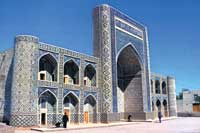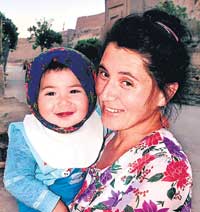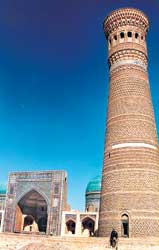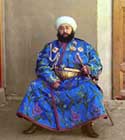
The Khorezm lands of PersiaFrom Khiva to Issy-Kul : An Islamic journey in the Central Asian heartlands of Timur (Part 3) Travelling across the expanses of the Kilizkum and Karakum deserts that occupied what C. Thubron titled wistfully The Lost Heart of Asia, I arrived late one cold night in fabled Bukhara. With a Lada for a camel and a driver who was now lost and incomprehensible, we searched fruitlessly for some modest accommodation. There, in a single exquisite unexpected moment which remains forever etched in memory, a time-warp occurred as I walked silently in search of a room through dark old alleyways at the edge of town, silhouettes of old mud walls and domes faintly outlined against the night sky. As I raised my head to a black steppe sky, the cold and my fog of desperation instantly evaporated as millions of twinkling diamond stars suddenly crystallized above me. The moment was exhilarating, beautiful in its silence, punctuated only by the occasional bark of an alley-dog; the many such nights, I surmise, that merchants on the Silk Road would have witnessed could not have been any different. Resplendent Bukhara The town straddles today’s desert-border between Uzbekistan and Turkmenistan - near Merv, another legendary caravanserai to the south. Originally founded as Numijket (6C AD) by a Turkic chief, it became Bukhara “The Pillar of Islam” three centuries later, resonating with over 300 mosques, 100 Koranic schools and over 12,000 students, a magnet for Central Asian scholarship. Fortunes waxed and waned over the centuries: the Arabs captured it in 676AD, the Persians overran it in 820AD, Kharakhanids made it an intellectual and commercial capital later, Genghis Khan seized it in 1220AD and Timur around 1370AD. While many monuments have vanished, it is still home to some 160 historical buildings, several restored (some say with questionable taste) during the time of the Soviet Union and yet a feast to the eye in the bright steppe daylight.
Towering above the town’s skyline is the exquisite Kharakhanid Kalyan Minaret (1127AD) whose simple splendour beguiled me. Rising 155 feet above ground with 33 feet of stone foundation, adorned by rings of earthen patterned tiles, brickwork and an ornate balcony, it was once the largest minaret in Central Asia. An irresistible urge to climb up through its narrow winding staircase yielded a panorama of the old town. A sense of foreboding could also be felt as Timur (and Genghis Khan) routinely executed those who fell out of favour by making them leap from its top. It is said that when the Great Khan stood beholding the minaret, a gust of wind blew his hat to the ground. As he stooped to pick it up, he declared that anything that makes him bow to it thus is something to be respected and his troops were ordered not to destroy it. Bukhara is home to over 30 medressas, such as those of Madar-i-Khan (16thC), Abdullah Khan and Kukeldash …with beautiful mosaics and Kufic calligraphy serenading rows of arcaded doorways. Elsewhere, ‘taks’ – arches or vaulted spaces – dating from Shaybanid era (15C AD) enclose the famed marketplaces, three of which (Tak-i-Zargaron (Jeweller’s Market), Tak-i-Tielpak Furusham (Hatmaker’s Market) and Tak-i-Sarrafon (Spice and now Moneychanger’s market) still can be seen. In another part, a citadel-fortress dominates, reminding me of a childhood visit to Aleppo in Syria (another caravanserai, then marked by Timur with a pile of 20,000 skulls). Home to some cruel rulers, this enormous rampart enclosed a city-within-a-city, and housed elegant royal apartments, shops and religious chambers. The fortifications signified Bukhara’s presence not as a mere historic town in Uzbekistan but that it had held its own as a Khanate and then Emirate until as recently as 1920 (-a wonderful photograph of its last Emir remains). In the evening, I wandered erratically into the Labi Hauz, a mulberry tree fringed square with an ornate pond at its centre, dating from 1620AD; then and now tea houses nestled in corners and locals sat in the porticos chatting amiably, enjoying the cool night air. The quiet ambience of the square typified the Turkic flavour of Central Asia, so different (to me) from the Arab world. (Indeed as H. Pope in The Rise of the Turkic World reveals in a contemporary worldview, the pervasive influence of a millennia-strong Turkic influence from Istanbul to Xinjiang is still today quite remarkable compared to the shorter colonial history we are familiar with.) From pools of light in a corner of Labi Hauz, there emanated rhythmic Turkic beats and as I peered inside one tea house, locals were gyrating with frenzied vigour to modern music. In search of a carpet A singular attraction in Bukhara was the chance to unload my now hazardous rucksack of Uzbek Soums which I had hidden through checkpoints to purchase a carpet. Though carpets and Bukhara are as synonymous as Ceylon Tea, the Bukharan carpet with its famous “gushy gul” [elephant footprint] motifs is a misnomer, being essentially a Turkmen product made by some of the most ancient and respected carpet weaving tribes in the world. Wandering through ‘taks’, my preference for Kizilayak geometric patterned styles, naturally dyed in a traditional dark red colouring, was sorely tried: the choices were many. Finally, after much pleasurable deliberation, an old repaired carpet was packed. Thereon very real worries of how I would take it home commenced (-artefacts over 40 years old were deemed to be of “historic” value or perhaps more accurately of some extractable benefit to Uzbek Customs). Across Kizilkum and Karakum deserts From Bukhara, it is a distance of about 550km in a north-westerly direction to Khiva. The landscapes peter out to an arid stony plateau stretching to the horizon, with the Karakum “Black Sands” Desert (350,000 sq kms) on one’s left into Turkmenistan and the equally featureless Kizilkum “Red Sands” (298,000 sq km) on the right. In the distance, occasional mini whirlwinds whip up sand which disappears into a sky devoid of clouds.
Gazing from my window, I see solitary horsemen herding scraggy sheep or goats, threading their way through a bleak scrub. These concealed fearsome deserts that camel caravans carrying goods westwards to Persia crossed in by-gone times, with the fire-beacons atop the minarets of Khiva and Bukhara guiding and uplifting the spirits of traders. The monotony of deserts was broken by the gradual approach of greater human presence as I neared Khiva in Uzbekistan’s far north-west region, known as Transoxiana. From ancient irrigated furrows, the largesse of distant settlements, to gradually ascending structures, one becomes aware of the presence of water, and a delta. Many old settlements that have disappeared with time lie scattered around the Oxus’ banks, some mere piles of mud bricks. Finally the distinctive 27 feet high and 2.1 km long mudbricked ramparts of Ichan Kala, Khiva’s inner town, with peeping minarets and fortified by 40 bastions, loomed into view. The Turquoise Minarets of Khiva Khiva exuded a different atmosphere to Bukhara or Samarkand, being closer to the Iranian sphere of influence. It lies some 1200 km from Tashkent and in the heartland of ancient Khorezm – a satrap (province) of ancient Persia that encompassed today’s Turkmenistan, Uzbekistan and the autonomous region of Karakalpakstan (a semi-autonomous part of modern Uzbekistan). From about 5C BC to 13C AD, Khorezm was an integral part of the Central Asian picture, though in 712 AD Arab occupation and the introduction of Islam (over Persian Zoroastrian religious influences) changed its nature. About 200 km to Khiva’s north-west was the former beautiful twelfth century Khorezm capital of Konya Urgench (“Heart of Islam”), a great city and caravanserai with a similar array of elegant medressas, palaces and scholarship to Bukhara and Samarkand. Its opulence in 12-13C AD was sadly irresistible; it was devastated by the Mongols (1221 AD) and Timur (1377 AD) and this subsequently gave greater prominence to Khiva, which benefited from its gradual spillover. Being also at the helm of a fickle, changing Oxus, Khiva became a critical stop on the physically hostile environment that the northern branch of the Silk Road stretched through on its way to the Caspian Sea and Russia. This oasis town’s golden days were between 995AD and 1040AD when under Seljuk rule, Khiva’s master craftsmen in ceramic, glasswork and metalware had no peers in the region. Irrigation systems too were constructed at this time (500 vineyards proliferated then). By 16C AD, as Bukhara waned, Khiva emerged as the capital of Shaybanids’ khanate in 1512. For three centuries Khiva’s cultural and economic importance shimmered in the desert heat, a veritable caravanserai attracting fame from far off Asian, Persian and Arabian lands. Many of today’s remaining monuments were constructed in 18-19C. In these final centuries, Khiva gained increasing notoriety as a dark and depraved settlement frequented by ferocious Turcoman tribes engaged in slave trading and for appalling cruelty exhibited by different rulers. How to woo a Khivan woman In 1875, the legendary Captain Frederick Barnaby, reputedly the strongest (and at 6’4” possibly the tallest) man in the British Army, an intrepid soldier-adventurer and a fellow Old Harrovian of my old school, rode over 1000 miles into Khiva (A Ride to Khiva (1876), an instant bestseller then and still a classic!) to unofficially evaluate whether the Russians intended to use it as a springboard into India (-this was the peak of “The Great Game” – see Travels in Buddhist Lands Along the Silk Road, Part 3: Gilgit, Baltit and Sost, Sunday Times Plus, Sept 19, 2004). His descriptions make for fascinating reading about the settlement but his own attempts, despite fluency in seven languages, to woo a local lady through an interpreter are amusing: “There are a good many ways of telling a woman she is pretty, but it is always difficult to do so through a third party… ”He says "that thou art lovelier than a sheep with a fat tail"- this appendage being a great delicacy amongst the Tartars - "that thy face is the roundest in the flock, and that thy breath is sweeter than many pieces of mutton roasted over bright embers.” I wonder whether he succeeded. Persian hinterlands Despite Khiva’s darker character, it is fortunate that from about the 18th century, Russian efforts to preserve and restore Khiva’s epithet as a “Pearl of the Desert” succeeded in retaining many of its key monuments and architectural legacy. The bewilderingly different but uniformly enchanting ceramic tilesmanship of the former Khorezm masters, in blues and white, captivated my eye as I visited the western end of town, housing royal family quarters. Exquisite inlaid balconies in the traditional geometric patterns adorn the Tash Kavli Palace grounds, high points in Central Asian art.
The Juma (Friday) Mosque (rebuilt from 10C AD foundations) in the heart of the old quarter, with its 218 carved wooden pillars in elegant floral and geometric shapes, still give shade and sanctity to worshippers. Minarets abound: Arabhana minaret (17C), Sherghazi Khan (18C), Rakim Khan, Allokuli Khan, Abdullah Khan, Muhammad Amin Khan (19C) and the 150 foot Islam Hoja (20C) all added their considerable splendours to the skyline as I threaded my way through the old streets lined with mudbricked houses. The Tomb of Sayid Allauddin commemorating a Sufic master who died in 1302 is the oldest surviving original building in Khiva (14C), with striking majolica decorations. Another distinctive facet of Khiva were the open family garden plots that dotted the old quarter. At the approach of a cooler dusk, families could be seen squatting, watering, digging and chatting in pleasant candour while children played with makeshift wheeled toys and dogs. After some door knocking, I stayed in a one-storeyed traditional home (family run “Hotel Arkanchi”) with an enclosed courtyard garden. It was the best accommodation I had encountered in this entire journey, clean, simple and quiet and with homely irrigated greenery that soothed my eyes as I sat on the balcony reviving my senses. Khiva was thus a personal oasis too. I took my meals in traditional style in a heavily carpeted dinning room brimming with “wall-to-wall” carpets (treasured heirloom carpets here grace walls, not just floors), dining often on a mixture of roast lamb, kebabs, nuts of all shapes and types, yoghurt drink, round thick chewy bread, vegetables and fruits, both fresh and dried. One afternoon saunter rewarded me with a particularly memorable encounter with a striking Tartar? woman, Rosa, cradling a cheerful baby whose smile still warms my heart. The ghost ships of Karakalpakstan About 250 km north-west of Khiva, there is less to cheer about. The autonomous state of Karakalpakstan was an area once made rich and fertile by the Aral “Sea”, the world’s fourth largest lake in 1960 (68,000 sq km – slightly larger than Sri Lanka). Soviet engineers then chose to divert waters to feed Uzbekistan’s vast cottonfields (“white gold”), triggering widespread desertification as the sea receded, shrinking 60% by surface area and 80% by volume, and the land became parched and heavily salinized.
Livelihoods were ruined and ghostly fishing trawlers still lie cemented in sands. With an environment contaminated by a noxious cocktail of residual sediment from fertilizers, pesticides, industrial and military pollution and dusted by toxic clouds, rates of abnormalities (1 in 20 have congenital disorders), maternal deaths, anaemic women (680,000 in 1995) and TB etc., soon mounted. While some valiant internationally supported efforts to contain and regenerate Aral’s ecosystem met with some success, seething long term problems remain. One wonders how the “vision” and results of “modern” engineering here can be so dramatically different from Timur’s realized vision of a garden city, the “Garden of the Blessed” in Samarkand . How could it have been allowed to go so wrong? The eventual need to return to Tashkent was disagreeable for Khiva was a veritable Arcadia, a most pleasant refuge; however, my anticipated destination was Kashgar (Xinjiang, China) through the southern Kyrgyz passes of Torugut and this was in an opposite direction to where I comfortably lay. With difficulties in logistics and time needed for lobbying for a Chinese visa, one mad dash to Tashkent took place: so between an 8 a.m. hurried breakfast in Khiva and a late 10 p.m. relieved-to-be-alive dinner in Tashkent, my Lada, powered by its sleep stricken driver, covered the requisite 1200 nonstop kilometres across the deserts (two flat tyres notwithstanding). Next week : through eastern Uzbekistan to Kyrgyzstan, the land of wildflowers and Celestial horses. |
|| Front
Page | News | Editorial | Columns | Sports | Plus | Financial
Times | International | Mirror | TV
Times | Funday
Times || |
| |
Reproduction of articles permitted when used without any alterations to contents and the source. |
© Copyright
2007 | Wijeya
Newspapers Ltd.Colombo. Sri Lanka. All Rights Reserved. |



